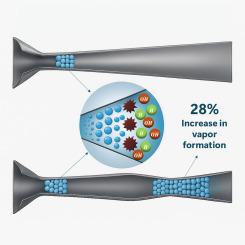文丘里反应器的几何优化,以提高流体动力空化效率:从传统到先进的串联配置
IF 7.1
Q1 ENGINEERING, CHEMICAL
引用次数: 0
摘要
本研究旨在提高传统和串联空化文丘里仪的效率。针对传统水动力空化反应器存在的降解效率低、蒸汽形成不足等问题,提出了一种串联布置的文丘里反应器。首先,对三个几何参数——收敛角、发散角和喉道长度——对传统文丘里管性能的影响进行了评估和验证。在确定了传统文丘里管的最佳配置后,应用了关键的几何因素来改进所提出的串联文丘里管系统。采用响应面法(RSM)分析了这些参数的影响和交互效应。在Ansys Fluent中以沿文丘里腔的蒸汽体积分数的面积加权平均值为目标函数对RSM建议的几何形状进行了模拟。结果表明,在常规构型下,发散角对蒸汽形成和空化区有显著影响。最终,优化过程确定了Conventional Venturi的理想尺寸:收敛角为80°,发散角为8°,喉道长度为4.65 mm。以这些尺寸为基准,对Tandem文丘里系统进行了优化,使其内部收敛角为40°,内部发散角为6°,喉管直径为4 mm和8 mm。与最佳的常规配置相比,优化后的串联文丘里(Tandem Venturi)的空泡形成率提高了28%。气泡形成的显著增强提高了整体空化效率并扩大了空化区域。本文章由计算机程序翻译,如有差异,请以英文原文为准。

Geometric optimization of venturi reactors for enhanced hydrodynamic cavitation efficiency: From conventional to advanced tandem configurations
This research aims to enhance the efficiency of conventional and Tandem cavitating Venturis. To address the limitations of Conventional hydrodynamic cavitation reactors, such as low degradation efficiency and insufficient vapor formation, a series-arranged Venturi system is proposed. Primarily, the impact of three contributing geometric parameters—convergence angle, divergence angle, and throat length—on the performance of a Conventional Venturi was evaluated and validated. After determining the optimal configuration for a Conventional Venturi, key geometric considerations were applied to refine the proposed Tandem Venturi system. The effects of these parameters and interactive effects were analyzed using Response Surface Methodology (RSM). The geometries suggested by RSM were simulated in Ansys Fluent, with the area-weighted average of vapor volume fraction along the venturi serving as the objective function. The results revealed that the divergence angle significantly influenced vapor formation and the cavitation zone in the conventional configuration. Ultimately, the optimization process identified the ideal dimensions for the Conventional Venturi: a convergence angle of 80°, a divergence angle of 8°, and a throat length of 4.65 mm. Utilizing these dimensions as a baseline, the Tandem Venturi system was optimized, resulting in an internal convergence angle of 40°, an internal divergence angle of 6°, and throat diameters of 4 mm and 8 mm. The optimized Tandem Venturi achieved a 28 % increase in cavitating bubble formation compared to the optimal Conventional configuration. This substantial enhancement in bubble formation improves overall cavitation efficiency and expands the cavitation zone.
求助全文
通过发布文献求助,成功后即可免费获取论文全文。
去求助
来源期刊

Chemical Engineering Journal Advances
Engineering-Industrial and Manufacturing Engineering
CiteScore
8.30
自引率
0.00%
发文量
213
审稿时长
26 days
 求助内容:
求助内容: 应助结果提醒方式:
应助结果提醒方式:


